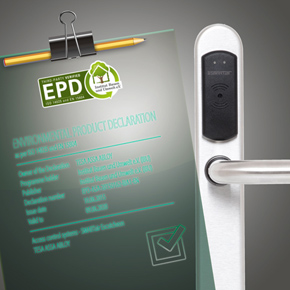
ASSA ABLOY Q&A: The key to locking sustainability
ASSA ABLOY has announced the publication of more than 40-product specific Environmental Product Declarations (EPDs) across its security product categories.
The publications cover mechanical locksets, cylinders, door closers, floor springs, multi-point locks, doors, handles, hinges, and electromechanical and other access control solutions.
The new brochures bring the total number of EPDs issued by the ASSA ABLOY Group close to 100.
In a recent Q&A, EMEA Sustainability Manager Charles Robinson explained the EPDs’ importance to ASSA ABLOY’s sustainability strategy, and how the publications can assist companies in building and running better buildings.
Q: Firstly, can you explain what an EPD is?

Charles Robinson of ASSA ABLOY EMEA
Charles Robinson (CR): An Environmental Product Declaration, or EPD, is a detailed assessment of a product’s impact during its whole life cycle.
It’s important to note that an EPD alone isn’t a certification of environmental credentials. Instead, it’s a complete mapping of the product footprint, from raw material, through manufacturing, logistics and impact during use, to end-of-life recycling.
Q: Why should an EPD be of interest to your end-users?
CR: Because without this kind of detail, it’s impossible to accurately assess a product’s environmental performance. An EPD helps a customer to make an informed choice prior to purchase, or to make an assessment of products already in use. For example, the recent EPD for our SMARTair™ wireless escutcheon details everything from the embodied carbon of the complete product and impact of carton and foam packaging, to the recycling potential of its steel and zinc content, among much, much more.
Q: Why does ASSA ABLOY invest time and money in publishing this information?
CR: Because sustainability is deeply embedded in our corporate culture, both within our operations and in our product innovation processes. Developing EPDs is another way for us to be open and transparent about our products. It also helps customers to make informed decisions about the security solutions they install.
Q: How can we hold an ASSA ABLOY EPD to account? Can they be compared to EPDs published by others, for example?
CR: The simple answer is standards. In ASSA ABLOY’s case, our EPDs are based on the ISO 14025 and EN 15804 standards, which are recognised internationally, included by all major green building assessment methods like LEED (Leadership in Energy and Environmental Design) and BREEAM (Building Research Establishment Environmental Assessment Method). Using ISO standards to create EPDs ensures environmental performance can be compared fairly across products and manufacturers. Our EPDs are independently researched by a third party, and then verified by the Institut Bauen und Umwelt (IBU) in Germany. Transparency in generating such important data is critical.
Q: Why do ASSA ABLOY use product-specific rather than generic, industry EPDs?
CR: It comes down to details—and details are crucial when we talk about sustainability. Without data and detail, sustainability is just a buzzword. Products validated by a generic EPD can be manufactured anywhere with a multitude of components, finishes and dimensions etc., so that kind of EPD can only give a loose indication of a product’s environmental impact. They are more like an estimate, based on industry data, than a genuine evaluation of environmental footprint. A product-specific EPD, however, details the precise environmental impact of the product based on a unique bill of materials.
Q: How could a customer use an EPD in practice?
CR: Armed with a product-specific EPD, building owners and contractors can receive additional credits and as a result achieve higher green building ratings in assessment methods such as LEED. The EPD for our SMARTair wireless access control escutcheon, for example, runs to 10 pages of detail aimed at any business genuinely committed to understanding what is in their building, and to reducing its environmental impact. We are proud of our products from a technical point of view, of course. We are also deeply committed to ensuring our solutions help customers to run more sustainable buildings.
Contact ASSA ABLOY Opening Solutions EMEA Digital and Access Solutions
Dukes Court/Dukes Street
Woking
GU21 5BH
United Kingdom
Web: About us | ASSA ABLOY
Email: [email protected]
Phone: 0049 30 8106 2970
Visit Supplier's page
Latest news

22nd November 2024
Insight Data: Using Marketing Data to Build a Successful Business in 2025
Alex Tremlett, Insight Data’s Commercial Director, discusses the challenges for construction firms in 2025 and shares six strategies for success…
Posted in Articles, Building Industry News, Building Services, Information Technology, news, Research & Materials Testing
22nd November 2024
Purplex: A tough Budget, but opportunity still knocks
Incoming governments, especially those with significant mandates, inevitably come into power on a tidal wave of optimism coupled with hope that ‘Things can only get better’. Andrew Scott, MD of construction-focused, full-service agency Purplex, talks…
Posted in Articles, Building Industry News, Building Services, Information Technology, news, Posts, Research & Materials Testing
22nd November 2024
Pop Up Power Supplies Gets Arty in Yorkshire
Pop Up Power Supplies has installed 13 new electricity units at The Hepworth Wakefield – read more in this article…
Posted in Articles, Building Industry News, Building Products & Structures, Building Services, Case Studies, Civil Engineering, Facility Management & Building Services, Garden, Hard Landscaping & Walkways, Landscaping, Posts, Restoration & Refurbishment, Retrofit & Renovation
22nd November 2024
OPT Services Revolutionises Fibre Cable Capping with Eco-Friendly Innovation
UK-based OPT Services has unveiled SlimLine™ Capping, a groundbreaking fibre cable protection solution that promises to deliver significant environmental and installation advantages to the fibre optic industry.
Posted in Articles, Building Industry News, Building Products & Structures, Building Services, Facility Management & Building Services, Information Technology, Innovations & New Products, Sustainability & Energy Efficiency
 Sign up:
Sign up: